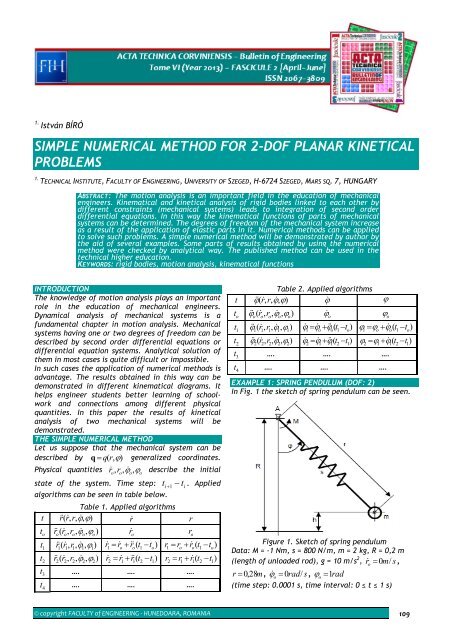a review - Acta Technica Corviniensis
a review - Acta Technica Corviniensis
a review - Acta Technica Corviniensis
Create successful ePaper yourself
Turn your PDF publications into a flip-book with our unique Google optimized e-Paper software.
1.<br />
István BÍRÓ<br />
SIMPLE NUMERICAL METHOD FOR 2-DOF PLANAR KINETICAL<br />
PROBLEMS<br />
1.<br />
TECHNICAL INSTITUTE, FACULTY OF ENGINEERING, UNIVERSITY OF SZEGED, H-6724 SZEGED, MARS SQ. 7, HUNGARY<br />
ABSTRACT: The motion analysis is an important field in the education of mechanical<br />
engineers. Kinematical and kinetical analysis of rigid bodies linked to each other by<br />
different constraints (mechanical systems) leads to integration of second order<br />
differential equations. In this way the kinematical functions of parts of mechanical<br />
systems can be determined. The degrees of freedom of the mechanical system increase<br />
as a result of the application of elastic parts in it. Numerical methods can be applied<br />
to solve such problems. A simple numerical method will be demonstrated by author by<br />
the aid of several examples. Some parts of results obtained by using the numerical<br />
method were checked by analytical way. The published method can be used in the<br />
technical higher education.<br />
KEYWORDS: rigid bodies, motion analysis, kinematical functions<br />
INTRODUCTION<br />
The knowledge of motion analysis plays an important<br />
role in the education of mechanical engineers.<br />
Dynamical analysis of mechanical systems is a<br />
fundamental chapter in motion analysis. Mechanical<br />
systems having one or two degrees of freedom can be<br />
described by second order differential equations or<br />
differential equation systems. Analytical solution of<br />
them in most cases is quite difficult or impossible.<br />
In such cases the application of numerical methods is<br />
advantage. The results obtained in this way can be<br />
demonstrated in different kinematical diagrams. It<br />
helps engineer students better learning of schoolwork<br />
and connections among different physical<br />
quantities. In this paper the results of kinetical<br />
analysis of two mechanical systems will be<br />
demonstrated.<br />
THE SIMPLE NUMERICAL METHOD<br />
Let us suppose that the mechanical system can be<br />
described by q = q( r,<br />
ϕ)<br />
generalized coordinates.<br />
Physical quantities r & , r ,ϕ&<br />
, ϕ<br />
o o o o<br />
describe the initial<br />
state of the system. Time step: ti+1 − ti<br />
. Applied<br />
algorithms can be seen in table below.<br />
Table 1. Applied algorithms<br />
t & r ( r&<br />
, r,<br />
ϕ& , ϕ)<br />
r& r<br />
t r&<br />
r&<br />
, r , ϕ& , ϕ ) r&<br />
o<br />
1<br />
&<br />
o( o o o o<br />
o<br />
&<br />
1( r&<br />
1,<br />
r1<br />
, ϕ&<br />
1,<br />
ϕ r (<br />
1 1<br />
= r&<br />
o<br />
+ & r<br />
o<br />
t 1<br />
−t<br />
o<br />
&<br />
2( r&<br />
2,<br />
r2<br />
, ϕ&<br />
2,<br />
ϕ2<br />
r2 = r&<br />
1<br />
+ & r<br />
1( t2<br />
−t1<br />
t r ) & ) r = r + r&<br />
t −t<br />
)<br />
2<br />
r<br />
o<br />
1 o o<br />
( 1 o<br />
r2 = r1<br />
+ r&<br />
1( t2<br />
−t1<br />
t r ) & )<br />
)<br />
t …. …. ….<br />
3<br />
t<br />
4<br />
…. …. ….<br />
Table 2. Applied algorithms<br />
t &<br />
ϕ ( r &,<br />
r,<br />
& ϕ,<br />
ϕ)<br />
ϕ& ϕ<br />
t & ϕ r&<br />
, r , & ϕ , ϕ )<br />
o<br />
1<br />
&<br />
o( o o o o<br />
ϕ&<br />
o<br />
&<br />
ϕ (&<br />
1 1,<br />
r1<br />
, & ϕ1,<br />
ϕ1<br />
ϕ 1<br />
= & ϕ o<br />
+ && ϕ o<br />
( t 1<br />
−t<br />
o<br />
&<br />
ϕ (&<br />
2 2,<br />
r2<br />
, & ϕ2,<br />
ϕ2<br />
ϕ<br />
2<br />
= & ϕ1<br />
+ && ϕ1<br />
( t2<br />
−t1<br />
ϕ<br />
o<br />
t r ) & ) ϕ = ϕ + & ϕ t −t<br />
)<br />
2<br />
1 o o<br />
( 1 o<br />
2<br />
= ϕ1<br />
+ ϕ1<br />
( t2<br />
−t1<br />
t r ) & ) ϕ & )<br />
t …. …. ….<br />
3<br />
t<br />
4<br />
…. …. ….<br />
EXAMPLE 1: SPRING PENDULUM (DOF: 2)<br />
In Fig. 1 the sketch of spring pendulum can be seen.<br />
Figure 1. Sketch of spring pendulum<br />
Data: M = -1 Nm, s = 800 N/m, m = 2 kg, R = 0,2 m<br />
(length of unloaded rod), g = 10 m/s 2 , r& o<br />
= 0m/<br />
s,<br />
r = 0, 28m , ϕ&<br />
o<br />
= 0rad/<br />
s, ϕ<br />
o<br />
= 1rad<br />
(time step: 0.0001 s, time interval: 0 ≤ t ≤ 1 s)<br />
© copyright FACULTY of ENGINEERING ‐ HUNEDOARA, ROMANIA 109

















